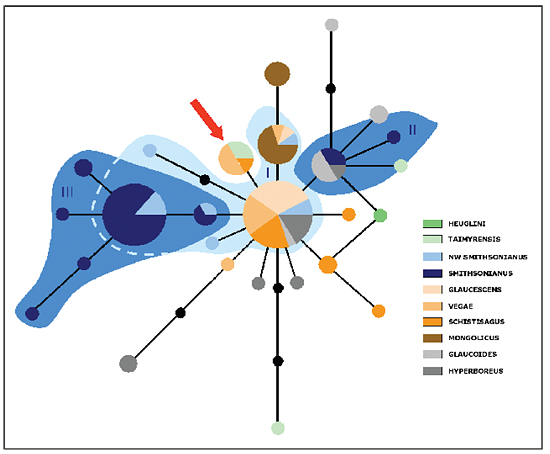 Thayer's Gull (thayeri)
Thayer's Gull (thayeri)
(last update: January 22, 2013)
Thayer's Gull adult August
The Beringian Connection: Speciation in the Herring Gull assemblage in North America.
by: Peter de Knijff, IN: Birding, July/August 2005. (FULL PDF)
The Iceland–Kumlien's–Thayer's Gull Complex
The taxonomic affinities among the various populations of these high-Arctic breeders remain very puzzling. Apart from the discussion about the scientific credibility of studies of whether Kumlien's Gull (Larus glaucoides kumlieni) is a valid taxon (Snell 1989), there is almost no reliable genetic data for this complex. It seems logical to conclude that Thayer's, Iceland, and Kumlien's are very closely related, with Kumlien's assuming an intermediate position with respect to distribution and phenotype (discussed in detail by Weir et al. 2000, Howell and Elliott 2001, Howell and Mactavish 2003). We have analyzed only a small number of Kumlien's from Home Bay, Baffin Island (n=7), and Crochet et al. (2002) present data from a single individual each of Iceland, Kumlien's, and Thayer's. As is clearly shown in Fig. 4, we find no differentiation between Kumlien's and the other Beringian taxa, corroborating the sparse results of Crochet et al. (2002). Obviously, many more individuals from different locations should be analyzed. The suggestion by Snell (2002) to isolate DNA from skins sampled at breeding colonies is a good one, at least for obtaining mtDNA sequence information. We are less optimistic that this approach would allow sequencing of nuclear DNA, and we hope that a young and ambitious scientist will pick up this Arctic challenge and collect new samples. To this end, we hereby offer our laboratory facilities once the samples have been obtained.
Fig. 4. This detailed network depicts all different Group H sequences in the Beringian group. The most ancestral sequence (i.e., the one closest to all other sequences according to the complete phylogenetic tree; see Fig. 1) is indicated with a red arrow. Each multicolored circle represents a single specific mtDNA sequence type, its size being proportional to the frequency of that sequence type in the entire sample. Small black dots represent inferred single-mutation steps (sequence types not found). Colors represent different "large white-headed gull" taxa as indicated in the legend and correspond with the geographical distributions as shown in Fig. 3 and the bars in Fig. 1, with one exception: Pale blue, used here to indicate sequences obtained from American Herring Gull individuals sampled in Alaska and the North West Territories, is used to indicate European Herring Gull in Figs. 1 & 3. The three different areas indicated as I–III represent three different groups of sequences observed among American Herring Gull. © Peter de Knijff.
 Thayer's Gull adult, August 30 2014, Qaanaaq - North Greenland. Picture: Rasmus Due Nielsen.
Thayer's Gull adult, August 30 2014, Qaanaaq - North Greenland. Picture: Rasmus Due Nielsen.